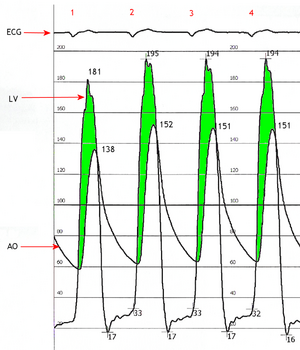Definition
When aortic valve stenosis occurs, the aortic valve, located between the aorta and left ventricle of the heart, is narrower than normal size.
Description
A normal aortic valve, when open, allows the free flow of blood from the left ventricle to the aorta. When the valve narrows, as it does with stenosis, blood flow is impeded. Because it is more difficult for blood to flow through the valve, there is increased strain on the heart. This can cause the left ventricle to enlarge and malfunction, resulting in reduced blood supply to the heart muscle and body, as well as fluid build up in the lungs.
Cause & symptoms
Aortic valve stenosis can occur because of a birth defect in the formation of the valve. Calcium deposits may form on the valve with aging, causing the valve to become stiff and narrow. Stenosis can also occur as a result of rheumatic fever. Mild aortic stenosis may produce no symptoms at all. The most common symptoms, depending on the severity of the disease, are chest pain, blackouts, and difficulty breathing.
Diagnosis
Using a stethoscope, a physician may hear a murmur and other abnormal heart sounds. An ECG, also called an electrocardiogram, records the electrical activity of the heart. This technique and chest x ray can show evidence that the left ventricle is enlarged. An x ray can also reveal calcium deposits on the valve, as well as congestion in the lungs. Echocardiography can pick up thickening of the valve, heart size, and whether or not the valve is working properly. This is a procedure in which high frequency sound waves harmlessly bounce off organs in the body. Cardiac catheterization, in which a contrast dye is injected in an artery using a catheter, is the key tool to confirm stenosis and gauge its severity.
Treatment
Treatment depends on the symptoms and how the heart's function is affected. The valve can be opened without surgery by using a balloon catheter, but this is often a temporary solution. The procedure involves inserting a deflated balloon at the end of a catheter through the arteries to the valve. Inflating the balloon should widen the valve. In severe stenosis, heart valve replacement is recommended, most often involving open-heart surgery. The valve can be replaced with a mechanical valve, a valve from a pig, or by moving the patient's other heart valve (pulmonary) into the position of the aortic valve and then replacing the pulmonary valve with an mechanical one. Anyone with aortic stenosis needs to take antibiotics (amoxicillin, erythromycin, or clindamycin) before dental and some other surgical procedures, to prevent a heart valve infection.
Prognosis
The prognosis for aortic valve stenosis depends on the severity of the disease. With surgical repair, the disease is curable. Patients suffering mild stenosis can usually lead a normal life; a minority of the patients progress to severe disease. Anyone with moderate stenosis should avoid vigorous physical activity. Most of these patients end up suffering some kind of coronary heart disease over a 10 year period. Because it is a progressive disease, moderate and severe stenosis will be treated ultimately with surgery. Severe disease, if left untreated, leads to death within 2 to 4 years once the symptoms start.
Prevention
There is no way to prevent aortic stenosis.
Key Terms
- Aorta
- The largest artery in the body, which moves blood from the left ventricle to the rest of the body.
- ECG
- Also called an electrocardiogram, it records the electrical activity of the heart.
- Echocardiogram
- A procedure in which high frequency sound waves harmlessly bounce off organs in the body providing an image so one can determine their structure and function.
- Cardiac catheterization
- A procedure in which dye is injected through a tube or catheter into an artery to more easily observe valves or blood vessels seen on an x ray.
- Left ventricle
- One of the lower chambers of the heart, which pumps blood to the aorta.
- Murmur
- An abnormal heart sound that can reflect a valve dysfunction.
- Rheumatic fever
- A bacterial infection that often causes heart inflammation.
- Pulmonary valve
- The valve located between the pulmonary artery and the right ventricle, which brings blood to the lungs.
Further Reading
For Your Information
Books
- Bender, Jeffrey R. "Heart Valve Disease." In Yale University School of Medicine Heart Book, edited by Barry L. Zaret, et al. New York: Hearst Books, 1992, 167-175.
- Braunwald, E. "Aortic Stenosis." In Heart Disease: A Textbook of Cardiovascular Medicine. Philadelphia: W.B. Saunders Company, 1997, 1035-1045.
- McGoon, Michael D. "Aortic Stenosis." In Mayo Clinic Heart Book. New York: William Morrow and Company, 1993, 65-66.
Other
- Loyola University Medical Center. "Aortic Stenosis," by Aly Rahimtoola. http://www.meddean.luc.edu/develop/arahimtoola/intro.htm.
- Ochsner Heart and Vascular Institute. "Aortic Stenosis." http://www.ochsner.org/pedcard/as.htm.
Gale Encyclopedia of Medicine. Gale Research, 1999.



